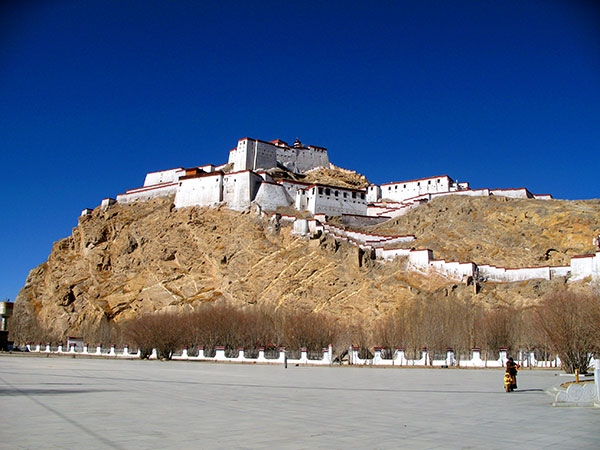Gyantse Dzong Overview
Different from other scenic spots celebrating Tibetan Buddhism, Gyantse Dzong (Chinese name: 江孜宗山抗英遗址) (Dzong Fortress) is famous for a patriotic story. In 1904, British troops invaded Gyangtse but encountered fierce opposition from the strong and brave Gyangtse people. They defended their city from a fortress on Zongshan Hill, using primitive guns and cannons, swords, and even bows and arrows to fight against their invaders. The famous cliff where this fight took place is located in the center of Gyangtse. It is 125-meter high and has an altitude of 4,020 meters.

On the site there are the former residence of one of the commanders and some vestiges of the emplacement.
History
Gyantse Dzong Zongshan Anti-British site is located at No.1 Zongshan Mountain on the city. 1903 (Guangxu period twenty-ninth year) British army invaded Tibet from the east of Asia and resisted by the Tibetan people. In 1904, the British advanced to Gyantse and attacked fiercely to Zongshan, the army and the people of China on the mountain to hold up to 3 months, beaten back the British attack repeatedly, eventually because of run out of ammunition with no reinforcements in sight, and they were outnumbered, Zongshan lost. In 1961 the state council of the People’s Republic of China announced it as the national key cultural relics protection unit.
It is the national key cultural relics protection units and the national patriotism education base. It stands in the middle of the ancient city of Gyantse, stands in the opposite of Palkor Monastery on the cliffs of the top of the mountain at an altitude of 4187 meters, the existing rooms are 193, ancient building 7064 square meters. Gyantse is the capital of ancient Sumpa, and Sontzen Gampo’s father subdued the Sumpa and then Gyantse became a noble fief, and developed the major thoroughfares for communication of Ü-Tsang. And due to it is the way which must be passed through Yadong Border Port, so it was still an important town in Tibet. Gyantse due to the special geographical position, convenient traffic, as well as the developed politics, culture and economics, it has important position in the history of Tibet, and has always been for the place of strategic importance. In the spring of 1904 AD, in the Zongshan Mountain Gyantse the military and civilian wrote down patriotism of epic chapter against the imperialist aggression and defended the motherland territory. From then on, people called Gyantse a hero city.
Zongshan, also the home of the old Tibetan government of Gyantse Dzong, here old Gyantse office, the trace of life, to chant Buddhist scripture, and so on and so forth still can be found. Four stone tablets that minister of the Qing dynasty Qianlong period made an inspection tour to borderland are still intact, so Zongshan also has its important value of cultural relics.
Geography
Gyantse Zongshan Anti-British Site is located in the north of Nianchu River branch of Yarlung Zangbo River in the back to the top of the Palkor Monastery mountain of Gyantse county, is 307 km from Lhasa, located in the communication hub to Yadong and Shigatse, is the thirtieth years’ reign of Qing emperor Guangxu period (1904) patriotic soldiers and civilians fought against British invaders sites in Tibet. With Zongshan high terrain, in order to fight against the British, people there built battery and other defenses in front of the mid-levels cliff, and used stone built 5-8 meters high and four meters wide fence. Now there is existing fort and sites.
What to See
Zongshan is not high, only 100 meters. But Gyantse is flat, so Zongshan stands head and shoulders above others, where is of great military significance. And Gyantse is more than 4000 meters above sea level, it is not easy to climb Zongshan. So Gyantse people early built castles, established Gyantse government on Zongshan as the portal of Lhasa. In Tibetan “Zong” means castles, fortress, and is also the name of the original Tibetan local regime at the county level administrative unit. Zongshan buildings built in the early 14th century, there were mainly Zongben (the head of county) office, assembly hall, temple and all kinds of warehouse, etc., all has been built from the hillside according to the mountain to the top of the mountain. In Gyantse Dzong Anti-British Site there is Anti-British battery, Head-Smashed-In Anti-British Warriors Jump, Gyantse government chamber and other attractions for tourists to visit.
► Head-Smashed-In Anti-British Warriors Jump: the Gyantse guardian war lasted three months, finally in the case of outnumbered, under the circumstance of running out of ammunition and food supplies the warriors never surrendered to the enemy, and jumped from Zongshan Mountain north cliff. Now here was established a monument.
► Stone Tablets that grand minister resident of Tibet made an inspection tour to borderland: stone carving in the Qing dynasty emperor Qianlong sixtieth year, recorded in Tibetan grand minister resident Songjun made an inspection tour to borderland and garrisoning frontiers.
► Gyantse Dzong Government Chamber: which reappears the situation of Dzong government officials at office, and in the exhibition hall the Gyantse Dzong government cadastre and other raw materials are very precious.
► Dharma Temple: built in the Ming dynasty, which is also called Ruyi Temple. Inside there are the evidences of the British invaded China’s Tibet.
Travel Guide
【Chinese Name】: 江孜宗山抗英遗址
【Recommended Visiting Hour】: 1 hour
【How to get to Gyantse Dzong】: Zongshan Anti-British Site is located in the center of Gyantse County, tourists can take long-distance bus to Gyantse and then walk there.
